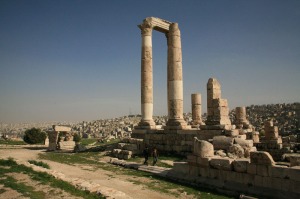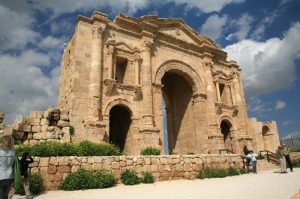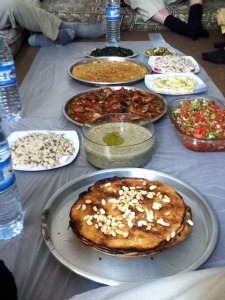The Treasury – Petra
[Click on picture for larger image]
Jordan is a small country but occupying a strategic location in the Middle East. It’s not rich like other countries in the area – no oil but lots of concrete and phosphate. Given the aridity of the country one doesn’t wonder why or how! King Abdullah isn’t as popular as his father Hussein but then he isn’t as profligate as the old man was. Besides, as they say, he’s young, he’s idealistic – he’ll learn…. and trying hard to raise his country out of the economic mediocrity in which it finds itself.
Amman from Citadel Hill
But it has an ace in the hole – tourism with several of the biggest attractions in the Middle East: Petra, Wadi Rum and the Dead Sea.
We arrived in Amman, Jordan in time for a traditional Jordanian lunch. As a typical hors d’oeuvre we began with mezze, a Middle Eastern selection of small dishes of various sorts, both hot and cold – all very tasty: babaghanoush (eggplant mashed and mixed with seasonings. I usually dislike eggplant having had, to me, bad experiences with it when much younger but this was quite enjoyable especially when dipped with pita bread which is served with all meals); hummus (one of my favourites with chickpeas or garbanzos); falafel (another favourite); kofte (meat balls consisting of ground lamb, mashed onions, spices and a small amount of ground veal and bread softened in raki); cacik (dip made from plain yogurt, chopped cucumber with finely chopped garlic and mint leaf); tabbouleh (bulgur, finely chopped parsley, mint, tomato, spring onion, with lemon juice, olive oil and seasonings); salads and olives, olives, olives – I love olives. It’s lunchtime while I’m writing this so you can tell where my mind (and stomach) is! The mezze was more than enough for lunch. However….

Mezze (from Wikipedia. Unfortunately my iPod image didn’t turn out well)
… following this we had another traditional Jordanian and Palestinian dish called mansaf, made of lamb cooked in a sauce of fermented dried yogurt and served with rice or bulgur. It is the national dish of Jordan. To a lesser degree it is also found in parts of Iraq, Syria, and Saudi Arabia. The name of the dish comes from the term “large tray” or “large dish”. It was very good and went well with a cool beer on a hot day.
I was hoping for a little nap time but off we went to the Amman Citadel sitting atop a high hill. Amman is one of the oldest continuously inhabited cities in the world dating back 3,000 years. It was once the capital of the Ammonites (if you’re into the Biblical thing) and it was here that David met Bathsheba (or so they say!).
The Amman Citadel’s history represents significant civilizations that stretched across continents and prospered for centuries, as one empire gave rise to the next, including the Romans and the Umayyad dynasty. Monuments to these still stand, of course.
Temple of Hercules on Amman Citadel Hill
It was beginning to look like another ABT tour (Another Bloody Temple) the next day when we took off for Jerash; however, our ABT tour turned out to be different than that in Egypt – more variety. Jerash, an ancient Roman city framed by the hills of Gilead, is located 48 kilometers north of Amman and is considered one of the largest and most well-preserved sites of Roman architecture in the world outside Italy. To this day, its colonnaded streets, baths, theaters, plazas and arches remain in exceptional condition. Within the remaining city walls, archaeologists have found the ruins of settlements dating back to the Neolithic Age, indicating human occupation at this location for more than 6500 years.
Hadrian’s Arch, Jerash
The highlight of the day was visiting with a family in their home and being served a home-cooked meal – always the best anywhere you go. It’s like when I come home after a long trip, I always have a plate of macaroni and cheese (good old comfort food!); it was the same here with this family (no, not macaroni and cheese!). Along with the usual mezze with its various dips, there were salads, chicken (delicious and tender), a meat pie, and… olives – all while lying indolently on low mats. I didn’t know what to do with my feet….
That evening I decided to stay in and refresh myself and had dinner with another of our participants – a former judge in the Supreme Court of Texas – but she wasn’t the hanging kind; she was a Democrat! In Egypt I had indulged in lentil soup at every opportunity I could and so I did that evening – so creamy and smooth. Jeez, it must be lunch time – I’m dwelling on food…. I never thought of myself as a gourmand but one’s taste buds and appetite are often expanded when travelling.
Okay, I’ve had lunch – not lentil soup and pita but peanut butter and bread, raw carrot sticks, cucumber, and … olives. Somewhat of a comedown from Middle Eastern food and not quite as exotic but it’ll do. Milk instead of wine.
One Thousand-Year-Old Olive Trees
We began to wend our way south of Amman towards Petra, Wadi Rum and Aqaba, Jordan’s port city in the south. On the way we stopped at Mt. Nebo, the mountain from where Moses purportedly was granted a view of the promised land that he would never enter. Moses wandered off never to be seen again – Deut. 34:1 (purportedly….) You biblical scholars can correct me if anything is amiss here. The view from the summit provides a panorama of the Holy Land and, to the north, a more limited one of the valley of the River Jordan. They say that Jericho is usually visible from the summit, as is Jerusalem on a very clear day. Some of my fellow travellers said they could see them but I never did – but then my eyes aren’t as young as they used to be! It was hazy – the view, not my eyes.
What I found to be of more interest were the mosaic floors which were found on the floor of the Byzantine church on the top of the mountain, first constructed in the second half of the 4th century to commemorate the place of Moses’ death.
Mosaic Floor, Mt. Nebo
And onward to Petra, passing through Medaba and St. Peter’s Greek Orthodox Church with its 6th century mosaic map of Jerusalem and Kerak Castle, one of the larger crusader castles in the eastern Mediterranean. Those guys sure knew how to construct castles! Those holes in the ceiling – did they serve as ventilation for the smoke from the fires? No, they used them to pour boiling oil on to their enemies on the floor below. As I said, those guys sure knew how to construct castles.
Deep within the deserts of Jordan lies the ancient city of Petra. Through a narrow gorge it emerges into view, revealing awe-inspiring monuments cut into the surrounding cliffs. Two thousand years ago, Petra stood at a crossroads of the ancient Near East. Camel caravans passed through, loaded with spices, textiles and incense from distant regions–and through such commerce, the city flourished. Its people, the Nabataeans, harnessed precious water, enabling the population to soar to perhaps 20,000.
The Nabataeans also erected monumental tombs, memorializing their kings and leaders. But over time political control changed, and so did trade routes. Eventually the city fell silent, forgotten by the outside world. Another name for Petra is the Rose City due to the color of the stone out of which it is carved – “a rose-red city half as old as time.” [John Williams Burgon ‘Petra‘]
The Treasury, as seen from al-Siq (translated: the shaft), entrance to Petra. The walls that enclose the Siq stand between 91–182 m (300–600 feet) in height along its 1200 m (3937 feet) length
The amazing thing about Petra is that only about 5% of the city has been uncovered. This boggles the mind when one sees what already has been discovered. From arenas, to causeways, to royal tombs, to libraries – all carved out of the solid red sandstone, starting at the top and working their way down. As usual there just wasn’t enough time to do this wonder any justice – I’m just thankful I had the opportunity of being able to see it. It was a very pleasant and moving stay at what is said to be the national symbol of Jordan.
And then on to Wadi Rum, massive rock peaks rising out of pink sands (and, yes, I did fill another vial for Lucy with this rose-coloured sand) made famous by T. E. Lawrence (Lawrence of Arabia fame) who operated out of here during the Arab Revolt of 1917-1918 against the Ottoman Empire. He called it the Valley of the Mountains whereas others call it the Valley of the Moon (go figure). In fact that’s what wadi traditionally means: valley. Here is what Lawrence wrote about Wadi Rum in his book The Seven Pillars of Wisdom:
“We looked up on the left to a long wall of rock, sheering in like a thousand-foot wave towards the middle of the valley; whose other arc, to the right, was an opposing line of steep, red broken hills….The hills on the right grew taller and sharper, a fair counterpart of the other side which straightened itself to one massive rampart of redness. They drew together until only two miles divided them: and then, towering gradually till their parallel parapets must have been a thousand feet above us, ran forward in an avenue for miles.
“They were not unbroken walls of rock, but were built sectionally, in crags like gigantic buildings, along the two sides of their street. Deep alleys, fifty feet across, divided the crags, whose plans were smoothed by the weather into huge apses and bays, and enriched with surface fretting and fracture, like design…. Dark stains ran down the shadowed front for hundreds of feet, like accidents of use. The cliffs were striated vertically, in their granular rock; whose main order stood on two hundred feet of broken stone deeper in colour and harder in texture…. They gave the finishing semblance of Byzantine architecture to this irresistible place: this processional way greater than imagination…. Our little caravan grew self-conscious, and fell dead quiet, afraid and ashamed to flaunt its smallness in the presence of the stupendous hills.” I couldn’t have said it better myself! Our time there was a simple desert getaway in a superb wilderness setting.
The Seven Pillars – from which Lawrence got his title
Our Camp, Wadi Rum
On to the shores of the Red Sea at Aqaba, Jordan’s only port. It was a relaxing and leisurely time at a fancy resort (aren’t all resorts supposed to be fancy?) and then back north to the Dead Sea.
“The water feels rather oily and thick, almost scummy but it’s clean – and you float as if you’re floating on air. I have never been able to float in my life – my bones and I always sank like a stone but on the Dead Sea I finally was able to do it: lie flat on my back, head tilted back with absolutely no effort whatsoever and with no fear of sinking! What a marvellous feeling gazing up at the sky and simply being…. And not even being able to sit up in the water – no treading water here; hell, I could hardly even get my legs down into the water! What an odd feeling.”
Full circle – and, no, I did not ride a camel in Wadi Rum like my fellow travellers. I’ve ridden camels in western China and in Morocco; the latter ride was not a good experience: the camels were … well, camels, but the so-called saddle was simply a bunch of carpets and what seemed like duvets heaped on the back of the camel with a cinch around the belly of the beast. And the ‘saddle’ kept slipping sideways with me hanging on for dear life (there were no stirrups, of course – why would they want to spoil the ride of your life?!). I finally told them to stop and fix the damn thing. I didn’t have any problems after that but I was glad when the ride was ended…. I walked back to camp. I feel I’ve met my obligations of riding a camel quite sufficiently thank you.
And, yes, I did fill another vial, this time with mud from the banks of the Dead Sea.
Sunset, Wadi Rum










